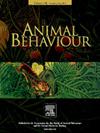Inference in wolves and dogs: the ‘cups task’, revisited
IF 2.1
2区 生物学
Q2 BEHAVIORAL SCIENCES
引用次数: 0
Abstract
Inferential reasoning, which refers to the process of arriving at a conclusion from a series of premises, has been studied in a multitude of animal species by using the ‘cups task’ paradigm. In one of the versions of this set-up, two opaque cups (one baited and one empty) are shaken in front of the animal. As only the baited cup makes a noise when shaken, the animals can locate the reward by inferring that only a baited cup would make noise that an empty cup would make no noise or both. In a previous iteration of this paradigm in wolves, Canis lupus, and dogs, Canis familiaris, wolves seemed to outperform dogs. However, assessing neither each species' inference capabilities, nor their relationship with each other was not feasible because of the lack of control conditions. In this study, several conditions in which the baited cup, the empty cup or no cups are shaken are added to tackle this issue. Results indicate that wolves and dogs made their choices based on the saliency and order of the stimuli presented and not based on inference, which is consistent with the previous study. In addition, the potential causes behind the animals' performance are discussed, and alternative paradigms that may be more apt to measure inference abilities in wolves and dogs are proposed in this study.
狼和狗的推论:“杯子任务”,重新审视
推理推理是指从一系列前提中得出结论的过程,已经在许多动物物种中使用“杯子任务”范式进行了研究。在其中一个版本中,两个不透明的杯子(一个是诱饵,一个是空的)在动物面前摇晃。由于只有带诱饵的杯子在摇晃时才会发出声音,因此动物可以通过推断只有带诱饵的杯子会发出声音,而空杯子不会发出声音或两者都发出声音来定位奖励。在之前对狼(Canis lupus)和狗(Canis familiaris)进行的重复研究中,狼的表现似乎优于狗。然而,由于缺乏控制条件,既不能评估每个物种的推理能力,也不能评估它们彼此之间的关系。在本研究中,为了解决这一问题,我们增加了摇饵杯、空杯或不摇杯子的几种情况。结果表明,狼和狗的选择是基于所呈现的刺激的显著性和顺序,而不是基于推理,这与之前的研究一致。此外,本研究还讨论了动物表现背后的潜在原因,并提出了更适合衡量狼和狗的推理能力的替代范式。
本文章由计算机程序翻译,如有差异,请以英文原文为准。
求助全文
约1分钟内获得全文
求助全文
来源期刊

Animal Behaviour
生物-动物学
CiteScore
4.60
自引率
8.00%
发文量
236
审稿时长
10.2 weeks
期刊介绍:
Growing interest in behavioural biology and the international reputation of Animal Behaviour prompted an expansion to monthly publication in 1989. Animal Behaviour continues to be the journal of choice for biologists, ethologists, psychologists, physiologists, and veterinarians with an interest in the subject.
 求助内容:
求助内容: 应助结果提醒方式:
应助结果提醒方式:


